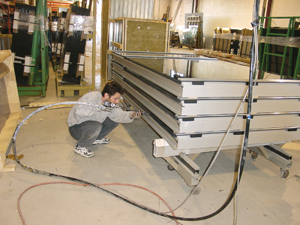
Features
Community
Event reports
Trying times
From raw material increases to skyrocketing fuel prices
October 30, 2008 By Pat Bolen*
With layoffs continuing in the manufacturing sector in both Canada and the United States and fuel prices steadily rising, the outlook for North American economy is uncertain. Glass Canada spoke to representatives of several companies to see how they are coping.
 |
| The quality of North American products is superior and lead times are certainly much better, but manufacturers say that in many cases it just comes down to price. |
From raw material increases to skyrocketing fuel prices, window manufacturers face pressure from several fronts
With layoffs continuing in the manufacturing sector in both Canada and the United States and fuel prices steadily rising, the outlook for North American economy is uncertain. Glass Canada spoke to representatives of several companies to see how they are coping.
David Devenish general manager of Fenzi North America says over the past two years the manufacturing sector has taken a huge turn in almost all sectors, whether it is automotive, retail or new home construction in the U.S. “Which for us in the glass business is directly related to slow window sales and the Canadian market has slowed as well for many of the same reasons.”
Devenish says the soft housing market caused by the sub-prime crisis has created an oversupply of homes with new home construction down by 40 to 50 per cent in many U.S. markets.
Pressures from outside North America are also effecting the economy says Devenish.
“Some raw material components used in insulated glass (IG) fabrication are being routed to Asia and other emerging markets, making North American fabricators scramble for their supplies. From our perspective, Fenzi has the ability to service our customers’ needs with their requirements for the IG components we supply.”
“The job loss by many workers has created high unemployment of upwards of 5.5 to six per cent as a national average in the U.S. and many consumers have had to delay either moving or any renovation projects they may be planning. You’re seeing an oversupply of raw glass with most manufacturers being below capacity. Over the last 12 months we have seen numerous plant closings as corporations try to consolidate and shift to more efficient locations, some being offshore.
“The Canadian market, while main-taining some positive growth numbers has seen similar closings and this shift to American production plants. The Canadian versus American dollar has caused much of this in addition to the imports from Asia. The pressure from fuel increases continues to erode at margins for all manufacturers and I don’t see any relief from this in the near future.”
One factor that has protected the Canadian economy to some extent, according to Devenish is the strong western Canadian markets.
“The 2010 Olympics in Vancouver has also helped and should continue for the next 16 months. As with other manufacturers, western Canadian businesses are subjected to higher costs and lower dollars for exports.
“Raw material increases are common occurrence’s in today’s market, at least from our perspective. We have some suppliers that send in monthly notices, again due to the energy feedstock needed for the chemical businesses. Steel, for example has seen increases of upwards of 40 per cent since January 2008. Our customers don’t see such monthly increases‚ but we continue to do research and development work to improve the quality of our goods to the market.”
Another factor for companies to deal with according to Devenish are labour shortages with the labour pool stressed in most North American markets and some regions not able to support second shifts.
“Some manufacturers have said that recent hires simply don’t show up after a few weeks on the job because they have found a different job at higher pay rates. Such a situation is going to prove quite difficult for those in the manufacturing sector over the next number of years.”
He adds, customers understand that price increases are a fact of the current state of the manufacturing business. Fuel surcharges, raw material increases all affect profit margins, so market increases are needed if manufacturers are to continue to support their customers’ needs.
“Canadian exporters have been hit particularly hard,” says Devenish “because of the higher Canadian dollar and the low demand in the U.S.”
“It’s a pretty simple fact of economics. That, combined with imports from Asia in many commodity type products, have combined to hurt the export of Canadian-made products. The quality of North American products is superior and lead times are certainly much better – but in many cases it comes down to price.”
 |

|
|
| The soft housing market caused by the sub-prime crisis has created an oversupply of homes with new home construction down by 40 to 50 per cent in many U.S. markets. | Among the rising prices for fuel and raw material components, steel, for example, has seen increases nearing 40 per cent since January 2008. |
What killed the residential new construction market?
Larry Johnson, executive vice president of Edgetech I.G. says a major factor affecting the North American economy over the past two years has been the mortgage crisis, which has essentially killed the residential new construction market.
“Fearful of finding themselves in foreclosure, people are not investing in new homes. Consequently, the replacement window market has also been affected by the mortgage crisis because home prices have dropped significantly in many areas, reducing the equity people once had in their homes. Without equity, many do not have extra money to spend on home improvements.”
This is a unique situation. “Typically, the replacement market and new construction market alternate. When one is lucrative the other is slow. However, in this instance, we are experiencing a slow market for both at one time, making it increasingly difficult for window manufacturers,” Johnson says, adding, “This is the first time that I can recall when both the new construction and replacement markets have slowed at the same time. With both markets down at the same time, the fenestration industry has been greatly affected.”
From a supplier perspective, Johnson says the Chinese demand for raw materials has been insignificant but the manufacturing sector has been hit hard.
“Over the past few years, rising fuel costs have been a major issue for manufacturers. The cost of moving products, whether raw materials or finished goods, has skyrocketed. Rising fuel costs have also increased operating expenses to heat and cool plants.”
“Companies that saved money during better times definitely have a distinct advantage right now. They are better prepared to weather the storm. Many of these companies are also taking advantage of the downtime to re-examine their products and processes to prepare for the better times ahead. On the flipside, companies that had weak financials before the market turned are not likely to make it through until the market improves.”
Customers have responded in different ways to price hikes, says Johnson.
“Many customers have launched pre-emptive strikes. They have issued letters saying that they will not accept price increases at this time or they attach a strict list of requirements for any price increases, which may include formal written documentation of the increase and a certain amount of advanced warning before the increase goes into effect.
“Often price increases are easier to swallow when you are offering customers value-added products and services that will help them differentiate themselves in some way versus the competition.
In response to their own rising costs, companies are passing on the increases to customers with different methods.
“A good example for this would be energy surcharges. Because it costs more to ship product, most companies today are adding fuel surcharges to invoices to pass along the additional costs to customers without increasing the cost of the product.”
The commercial market remains strong, despite the downturn in the residential market, says Johnson. “Historically, it has taken approximately 18-24 months for the commercial market to follow the residential market and we are now entering that time period. There is definitely some indication that the commercial market is slowing.”
The Canadian economy is still doing well especially in western Canada, according to Johnson. “We are seeing some minor slowing in certain areas. It is natural for Canada to be affected somewhat by the U.S. economy, but we are hopeful that the downturn will not be as significant in Canada.”
Johnson says the biggest challenge is that there are very few new business opportunities given the economy, so everyone is after the same pool of customers. “Many manufacturers are taking this time to improve upon their products to sell more value to customers. Product differentiation is one of the keys to survival in this economy.”
Labour shortage not limited to the west
Betty Ann Ratchelous, sales and estimating at Cole Harbour Glass Limited in Dartmouth, N.S. says they have not noticed any slowdown in their business in the last two years.
“We are extremely busy here in the Maritimes. Our biggest problem in this industry is qualified labourers. That’s basically been a problem for the last year.”
Ratchelous says she knows of one company in Nova Scotia doing large contract glazing work that announced it was pulling out because of the shortage of skilled workers.
“Many have gone out west,” says Ratchelous. “There just isn’t enough to go around.”
She adds that even paying premium wages is not enough to solve the problem. “They’re not there to get.”
“What we’re finding here is that the building just isn’t stopping,” says Ratchelous.
Without a lot of manufacturing in the Maritimes, Ratchelous says any glass they get is coming from Toronto or Montreal. “So you’re dealing with higher freight costs, including the stuff that comes from the U.S. So that has helped to increase prices. But it hasn’t stopped people from buying.”
Ratchelous says there has probably been a four per cent increase in freight charges as well as the energy surcharge, which is levied by glass distributors and ranges from eight per cent to as high as 13 per cent. “Years ago we didn’t have that kind of thing.”
While Cole Harbour hasn’t turned any work down, Ratchelous says they make a point of telling people it will take longer to get to them, which she says does not seem to be a problem.
Despite the economic growth that some provinces in western Canada are experiencing, manufacturers west of Ontario are still maintaining a degree of caution.
“I’m not going to call things buoyant, but there is certainly less pessimism in our marketplace than in some other areas,” says Al Dueck, president of Duxton Windows and Doors in Winnipeg, Man.
Dueck adds that as long as the global economy and commodities remain strong the overall Canadian economy will probably be stronger than it is usually given credit for.
“We’re working on what should become another good year,” says Dueck, who adds Duxton does more light commercial work than residential.
“We do more of an upscale type of package…we work hard at differentiating ourselves with those kinds of characteristics that I think are going to continue to grow in demand. Our sense is that in the marketplaces where fibreglass has been a bit of a sleeper, there’s a bit more of a demand there and some of the signs are giving us continued opportunity to grow.”
 |
|
| The Canadian versus American dollar has caused much of the pressure in addition to the imports from Asia. |
Upward cost pressures
While Dueck says overall in the United States he has been hearing there has been a substantial decline, in certain segments of the market there has been continued strength.
Regarding price increases, Dueck says there are two sides to the issue with items such as aluminum rising not just due to energy costs, but also because they are measured in U.S. dollars. “Clearly, there are signs that there are upward cost pressures, but they haven’t been huge at this point.”
Dueck says the stability in pricing that companies grew used to in the last 10 to 15 years is changing and the trend will probably continue until the demand for commodities softens. Higher commodity costs are also affecting the cost of finding labour, says Dueck, especially going further west than Manitoba.
Companies that are heavily dependent on the U.S. market have been hit to one degree or another, says Dueck. With the rise of the Canadian dollar and the new residential market shrinking by as much as 50 per cent, “you better be on your toes to make up for that.”
The amount of work that Duxton does in the American market at this stage is relatively small, says Dueck. “We see some opportunity, but again it’s a bit more of a niche market.”
Despite the weakening American market, Dueck notes that even if the market shrinks by a million housing starts a year, it could be offset by a million new housing starts in that same year. “From that point of view, we…need to be on our toes and be aware of the issues and make sure what we’re doing makes sense.”
Dueck says much of the pressure on commodities has been coming from countries such as China, but with the 2008 Olympics over there are signs that demand is softening and the financial problems faced in North America may spread to other countries.
While high fuel prices mean challenges for glass companies with customers looking harder at what projects they may do, Dueck says glass companies need to look at what opportunities the same high prices may bring to give customers a higher performing product such as triple lite window units.
With Duxton being a young company that started in 2000, Dueck says there are a lot of things it is still learning, “and maybe that gives us some advantage, that we’re not just stuck in our old ways.”
Duxton has had to increase some of its prices, but Dueck says with its focus on a performance oriented, design driven market, “we’re trying to not worry about the race to the lowest price, but trying to make sure we’ve got ourselves focused on a quality product with a good business model.”
Bill Marchitello is director of marketing for Prelco Inc., in Rivière-du-Loup, Que., and describes the current situation as the end of a 10-year cycle which has been good in the fabrication business with approximately 90 per cent of Prelco’s work architectural.
“This year is still a good year, very positive and orders are maintaining and we’re growing.” Marchitello is not so optimistic about 2009 though, which he says will not be terrible with a lot of projects planned, but he does not see big projects being worked on as much as he has seen in the last two years.
“We can see the first half of 2009 as okay. We don’t see much beyond that. If I had to predict, I’d say that the second half of 2009 will probably tail off…we’ve been going through boom years, it’s been very good for the architectural business.”
 |
| Companies that are heavily dependent on the U.S. market have been hit to one degree or another and Canadian exporters have been hit particularly hard. |
Marchitello says price increases are currently a common denominator to the business and glass related prices are skyrocketing.
With Prelco covering a wide geographic area, Marchitello says fuel prices have been a factor as well as the U.S. dollar. “It has hurt us somewhat, trying to sell farther than our home base.”
Marchitello says Prelco has been able to avoid most of the pressure from Asian competitors and demand for raw materials. “There has been some, but it hasn’t affected us greatly.”
The biggest challenge for Prelco, says Marchitello is maintaining its market share. “We are a company that likes to offer value added products…and that’s what keeps us abreast of any downturn.”
Offshore pressure
While there are customers that look for less expensive products, Marchitello says it is less affected than residential markets. “They just don’t buy or they buy the cheaper products. But architects, before buying cheaper products, they think twice.”
Along with most of its competition, Prelco has had to increase its prices. “We don’t have a choice…we’re still spending, we’re still expanding.”
Price hikes are always difficult, says Marchitello. “There are some areas in our business, when we’re quoting projects we are forced to eat some of the price increases and some of it we can pass on. It just depends on the timing of the projects and we deal with it on a project by project basis.”
“Most customers are in the same world we’re in so they realize that prices are on the way up…that certainly helps the situation.”
Jan Duggan is manager of Ideal Glass in Cannington, Ont., and says within a three month period, glass and mirror prices have increased “quite extensively. It’s hitting at a very difficult time as consumers are hanging onto their money, specifically because the media has put the fear of God into them…it all depends on the consumer as the end result.”
Duggan said Ideal is also fighting offshore pressures from imports as well. “Importing of finished materials or even the importing of raw materials…it makes it very difficult to purchase for instance, domestic products as a raw material, fabricate it and sell it when our customers are going ‘well, I can buy the same thing over here for considerably less money.’ And there is nothing we can do about it, unless we jump on the same bandwagon and purchase from offshore.”
Duggan says the pressure is coming from their customers, “who are saying they need to pay less and less. Which we understand because the end consumer is saying ‘I’m not going to pay this because can I buy something identical for considerably less.” We know that it’s coming offshore as a finished product. It’s very competitive and very difficult and it’s a very trying time for the glass industry itself and anyone who deals in glass.”
In order to compete, Duggan says Ideal is focusing on new and innovative ideas which cannot be produced overseas as easily, such as the custom side of the market. “You can’t get customization offshore. You could possibly, but you’re looking at six to eight weeks before you’re getting it. And at that point, you’re better off purchasing it locally.”
As well as turn-around times being a strength for Ideal, Duggan says customer service is another selling point for the company. “And I think skill within the staff…some who have been with us for up to 35 years.”
Ideal has also faced drastic price hikes on its raw materials in the last three months that amount to 20 per cent. “That’s large… and we’re forever confronted with the ever rising energy surcharges.
“We have no choice,” says Duggan. “We have to pass them on unless the government puts a tariff on offshore products.”
Cautious optimism
Cautious optimism seems to be the opinion of many people in the glass industry in many parts of Canada and the United States although there is a reluctance to predict more than a year or so and it appears that Ontario has been hit harder than companies in other parts of the country.
Despite the continuing expectations of a softening economy, recent reports may make companies more optimistic about the future. On Aug. 28, the U.S. Commerce Department said consumer spending and net exports were more vigorous than initially estimated and inventories fell less sharply. The department added that strong exports and consumer spending supported by government stimulus checks drove the U.S. economy up 3.3 per cent annual rate in the second quarter, much faster than first thought. Other factors that may affect
the economy in North America are the end of the Olympic cycle in China that may take pressure off raw materials and the coming of the 2010 Olympics in Vancouver that may give Canadian businesses a boost. In the long-term, while the economy will pick up, it appears companies in areas such as the Maritimes will continue to experience labour shortages, resulting in both higher labour costs and the inability of companies to expand. n
* Pat Bolen is a freelance writer who is based in Blyth, Ont.
Print this page